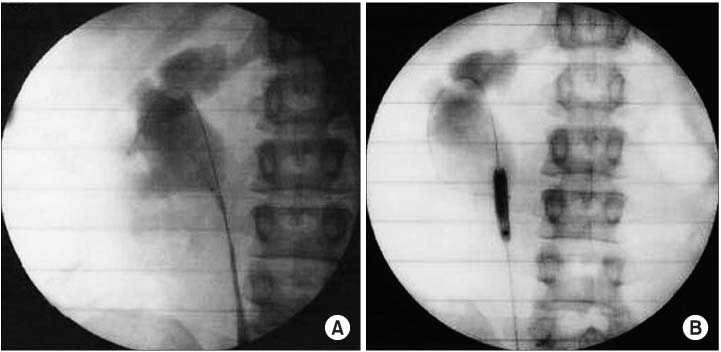Korean J Urol.
2006 Aug;47(8):818-823. 10.4111/kju.2006.47.8.818.
Endopyelotomy and Endoureterotomy with the Ureteral Cutting Balloon Device (Acucise(R))
- Affiliations
-
- 1Department of Urology, College of Medicine, The Catholic University of Korea, Seoul, Korea. urocsy@yahoo.co.kr
- KMID: 2294108
- DOI: http://doi.org/10.4111/kju.2006.47.8.818
Abstract
-
PURPOSE: Endourological management of ureteropelvic junction obstruction (UPJO) has gained increased acceptance with high procedural success rates and low morbidity being reported. It has been suggested that Acucise endopyelotomy should be the procedure of choice for patients with UPJO. The purpose of this study is to determine the efficacy of the Acucise balloon for the treatment of ureteral strictures and UPJO.
MATERIALS AND METHODS
Between March 2004 and June 2005, 13 consecutive patients (8 primary and 5 secondary cases of UPJO) underwent Acucise endopyelotomy at our institution. The preoperative evaluation included ultrasound and/or intravenous urogram with diuretic renography. The success of the procedure was based on objective radiologic improvement and the subjective resolution of symptoms.
RESULTS
The mean follow-up was 6.77+/-3.83 months (range: 3-14). The mean operating time was 64.23+/-34.87 min and the mean hospital stay was 4.15+/-2.44 days. The objective success rate was 61.5% and the subjective success rate was 69.2%. There were no major complications such as vascular injury requiring transfusion. Yet a small urinoma developed in one patient. Of the 5 objective failures, 3 patients have since successfully undergone open pyeloplasty.
CONCLUSIONS
In this small series, Acucise endopyelotomy is a safe and minimally invasive procedure that offered effective first-line treatment for UPJO, although multicenter randomized trials are needed to make a better comparison with the other techniques.
MeSH Terms
Figure
Cited by 1 articles
-
Successful Endourologic Management of Lower Pole Moiety Ureteropelvic Junction Obstruction in a Partially Duplicated Collecting System
Eugene Hwang, Young Ho Kim, Seung Woo Yang, Chang Shik Youn, Seung Mo Youk, Chong Koo Sul, Jae Sung Lim
Korean J Urol. 2010;51(6):434-437. doi: 10.4111/kju.2010.51.6.434.
Reference
-
1. Notley RG, Beaugie JM. The long-term follow-up of Anderson-Hynes pyeloplasty for hydronephrosis. Br J Urol. 1973. 45:464–467.2. Brooks JD, Kavoussi LR, Preminger GM, Schuessler WW, Moore RG. Comparison of open and endourological approaches to the obstructed ureteropelvic junction. Urology. 1995. 46:791–795.3. Kadir S, White RI, Engel R. Balloon dilatation of a ureteropelvic junction obstruction. Radiology. 1982. 143:263–264.4. Inglis JA, Tolley DA. Ureteroscopic pyelolysis for pelviureteric junction obstruction. Br J Urol. 1986. 58:250–252.5. Biyani CS, Cornford PA, Powell CS. Retrograde endoureteropyelotomy with the holmium:YAG laser. Initial experience. Eur Urol. 1997. 32:471–474.6. Doo CK, Kang TJ, Park SC, Hong BS, Park HK, Park TH. Long-term outcome of endopyelotomy for the treatment of ureteropelvic junction obstruction. Korean J Urol. 2005. 46:829–834.7. Chandhoke PS, Clayman RV, Stone AM, McDougall EM, Buelna T, Hilal N, et al. Endopyelotomy and endoureterotomy with the acucise ureteral cutting balloon device: preliminary experience. J Endourol. 1993. 7:45–51.8. Nakada SY, Pearle MS, Clayman RV. Acucise endopyelotomy: evolution of a less-invasive technology. J Endourol. 1996. 10:133–139.9. Gelet A, Combe M, Ramackers JM, Ben Rais N, Martin X, Dawahra M, et al. Endopyelotomy with the Acucise cutting ballon device. Early clinical experience. Eur Urol. 1997. 31:389–393.10. Willard TB, Williams C, Krishnan R, Carson CC. Acucise endopyelotomy: a successful therapeutic intervention in the treatment of ureteropelvic junction obstruction. Tech Urol. 1998. 4:118–123.11. Eden CG. Treatment options for pelvi-ureteric junction obstruction: implications for practice and training. Br J Urol. 1997. 80:365–372.12. Nakada SY. Acucise endopyelotomy. Urology. 2000. 55:277–282.13. Biyani CS, Minhas S, el Cast J, Almond DJ, Cooksey G, Hetherington JW. The role of Acucise endopyelotomy in the treatment of ureteropelvic junction obstruction. Eur Urol. 2002. 41:305–310.14. Brooks JD, Kavoussi LR, Preminger GM, Schuessler WW, Moore RG. Comparison of open and endourologic approaches to the obstructed ureteropelvic junction. Urology. 1995. 46:791–795.15. Nadler RB, Rao GS, Pearle MS, Nakada SY, Clayman RV. Acucise endopyelotomy: assessment of long-term durability. J Urol. 1996. 156:1094–1098.16. Nakada SY, Wolf JS Jr, Brink JA, Quillen SP, Nadler RB, Gaines MV, et al. Retrospective analysis of the effect of crossing vessels on successful retrograde endopyelotomy outcomes using spiral computerized tomography angiography. J Urol. 1998. 159:62–65.17. Kletscher BA, Segura JW, LeRoy AJ, Patterson DE. Percutaneous antegrade endopyelotomy: review of 50 consecutive cases. J Urol. 1995. 153:701–703.18. Moon YT, Kerbl K, Pearle MS, Gardner SM, McDougall EM, Humphrey P, et al. Evaluation of optimal stent size after endourological incision of ureteral strictures. J Endourol. 1995. 9:15–22.19. Kerbl K, Chandhoke PS, Figenshau RS, Stone AM, Clayman RV. Effect of stent duration on ureteral healing following endoureterotomy in an animal model. J Urol. 1993. 150:1302–1305.
- Full Text Links
- Actions
-
Cited
- CITED
-
- Close
- Share
- Similar articles
-
- Evaluation of Optimal Stent Size after Endourologic Incision of Ureteral Strictures
- Successful Endourologic Management of Lower Pole Moiety Ureteropelvic Junction Obstruction in a Partially Duplicated Collecting System
- The Outcome of Endourologic Treatment for Benign Ureteral Strictures
- A Comparison of Minimally Invasive Surgical Techniques for Ureteropelvic Junction Obstructions: Endopyelotomy, Acucise Endopyelotomy, and Laparoscopic Pyeloplasty
- Endoscopic surgery for management in stricture of ureteropelvic junction, ureter or caliceal neck


